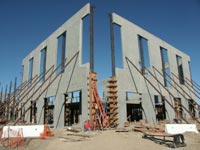Berkeleyan
Six-percent cut for UC in final state budget
Funding for enrollment and outreach is restored, however
![]()
| 18 August 2004
| |  Construction continues at UC Merced, the first new campus to be built since UC Santa Cruz in 1965, as plans to welcome its first students a year from now proceed with assured funding. The Classroom Building (above) is one of three academic buildings currently under construction. The 95,000-square-foot, three-story building will house a 360-seat auditorium, lecture halls, classrooms, computer labs, incubator space, multi-media and studio arts spaces, and faculty and graduate student offices. (UC Merced photo) |
The 2004-05 state budget adopted by the Legislature and signed by Gov. Arnold Schwarzenegger on August 6 reduces state funding for the University of California by six percent but restores funding for student enrollments and K-12 academic development programs previously proposed for reductions.
“This is the fourth year of cuts for the University of California, but it appears we are at last turning a corner,” said UC President Robert Dynes. “The Legislature and governor made clear in this budget that student access to a UC education is critical to the future of California, and we believe they have made a very wise investment. In addition, our new compact with the governor provides some light at the end of the tunnel and offers the hope that we will be able to stabilize, plan for the future, and begin to grow once again to meet California’s needs.”
UC’s state-funded operating budget will fall from $2.9 billion last year to $2.72 billion, a reduction of six percent. This reduction will be made up through program cuts and student fee increases. In addition, no state funding is provided for employee cost-of-living increases, though the compact offers funding for faculty and staff salary increases beginning in 2005-06.
Details on the compact — which outlines the governor’s intentions for funding UC over a several-year period beginning in 2005-06 and also lays out performance and accountability expectations for UC — are available at www.universityofcalifornia.edu/news/compact/. A link on that page accesses a PDF file of the compact text itself.
The final 2004-05 budget for UC includes the following provisions:
Enrollments: The governor’s original budget proposal cut UC freshman enrollments by 10 percent and redirected those students to a program in which they could transfer to UC as juniors after attending community college. The final negotiated budget, however, provides the funding for UC to offer freshman admission to these students who originally were offered the “Guaranteed Transfer Option” (GTO). Because of capacity constraints, three campuses — UC Berkeley, UCLA, and UC San Diego — will offer admission only to those freshmen who accepted the GTO when it was offered to them. (See “‘Re-directed’ freshmen now Berkeley-bound,” page 7, for more information.)
K-12 academic development: The final budget preserves $29 million in previously threatened state funding for UC’s academic development (or outreach) programs in California’s K-12 schools. However, $4 million in internal UC funding that previously supported these programs will now be used to fund the enrollment restoration described above. As a result, these academic development programs will see a net $4 million reduction from last year’s funding levels.
Administration and libraries: The budget includes a 7.5-percent ($45.4-million) cut to academic and administrative support, including libraries.
Research: The budget includes a 5-percent ($11.6-million) reduction in state-funded research, on top of the 20-percent cut these programs have taken over the previous two years. However, the final budget preserves all but $200,000 in funding for one research program, the Institute for Labor and Employment, that previously had been threatened with elimination of its $4 million in state funding.
Unallocated reductions: The final budget includes several further, unallocated reductions totaling approximately $50 million. Campuses and the Office of the President will be asked to find ways of achieving savings to accommodate this cut.
Student fees and financial aid: The Board of Regents set 2004-05 student fees in May based on the best information available about the likely budget outcome, and the final budget confirms those actions. The additional fee revenue will replace state funding being cut from the University. Resident undergraduate fees will increase by 14 percent, resident graduate academic fees by 20 percent, nonresident tuition by 20 percent, and most professional-school fees by higher, varying amounts. UC will be able to devote 20 percent of new fee revenue to financial aid, instead of the usual 33 percent, but will regain flexibility in this area beginning in 2005-06 under the compact. In addition, the final budget funds Cal Grants at a level that will cover the fee increase for eligible undergraduates.
UC Merced: The final budget preserves the level of funding offered in the governor’s original budget proposal ($10 million in one-time funding in addition to $10 million in permanent funding), allowing UC’s 10th campus to open to students in fall 2005. The $20-million allocation will help fund faculty hiring, enrollment and student-support services, library materials, and operational expenses associated with serving 1,000 students next year.
Salaries: The budget includes no funding for cost-of-living increases in 2004-05, though, as noted above, the compact would provide for such funding beginning next year.
The budget also restores $80.5 million in state funding that had been cut from UC’s budget on a one-time basis in 2003-04.
With respect to funding for capital outlay, the budget provides $339.4 million in general obligation funds and $55 million in lease revenue bonds, fully funding the University’s request for 2004-05. Projects funded address seismic safety issues, enrollment growth, modernization, and infrastructure needs.

